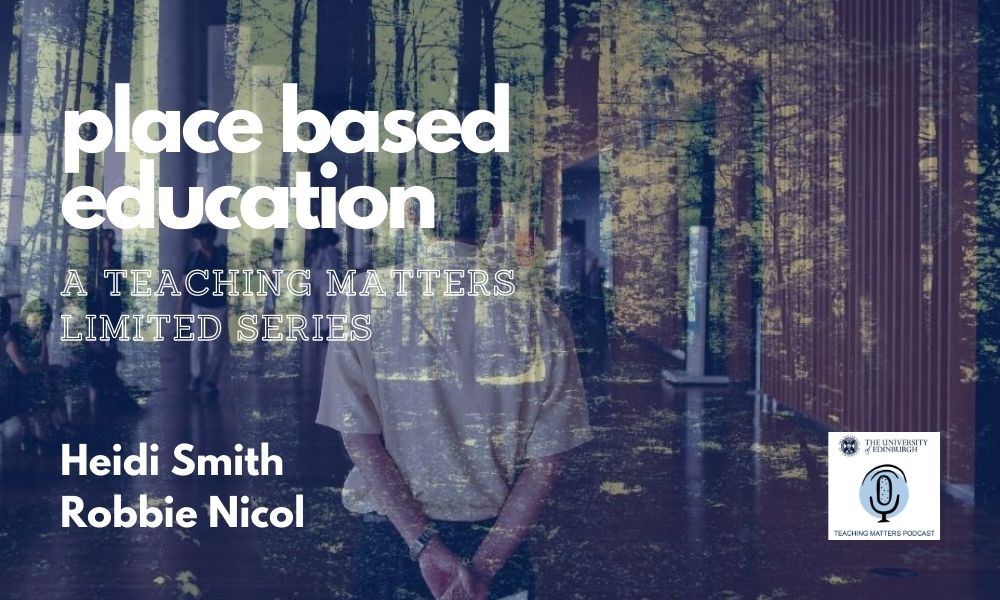
This podcast series focuses on creative approaches to practicals and field work in online and hybrid spaces. Robbie Nicol, a professor of place based education, and Heidi Smith, a lecturer of outdoor learning at Moray House School of Education and Sport, discuss the critical role of place based education in hybrid teaching and learning and it’s capacity to support health and wellbeing. Below is an edited transcription of Robbie and Heidi’s conversation from part 1.
WHAT IS PLACE-BASED EDUCATION?
Heidi Smith: For people who might not have come across the term before, can you say a little of what Place-Based Education means for you?
Robbie Nicol: Place-Based Education places students within local heritages or cultures, or landscapes and it provides opportunities for experiences of what we might call the ‘affordances’ of different places and spaces. What’s key to Place-Based Education is interdisciplinarity and although Place-Based Education does tend to want to draw together subject specialisms, it does so to deal with real world problems. So Place-based Education is not simply a theoretical concept, it’s something that is supposed to be applied to problems and as such it draws on all subject areas from the arts, humanities and sciences.
Heidi Smith: What I’m hearing, is that Place-Based Education really incorporates local and global and experiential learning experiences but most importantly it incorporates relationships. Is that what you’re saying?
Robbie Nicol: You’ve really drilled down into the three key principles of Place-Based Education.
- When we talk about local, it might simply be a lecturer taking their students out on a learning journey walk into Holyrood Park or down Holyrood High Street. It could be a based on a subject specialisms e.g. geography based, or something ever more interdisciplinary.
- Equally, it could be global in the sense that Place-Based Education focuses on the idea that there are things happening in places in which we are not present and we need to be aware of them. For example, climate change is a global phenomenon, but it affects us locally as well. Thinking globally also includes our students going from our Edinburgh-based campus to places of inequality to experience first-hand problems that exist in both the Global North and the Global South.
- The third thing is that Place-Based Education is experiential. Some form of experiential engagement is central to Place-Based Education because we believe that you can understand things theoretically, but it’s when you are engaged experientially that your emotional instincts allow you to experience inequalities first-hand as well as understanding their theoretically significance.
PLACE-BASED EDUCATION IN PRACTICE
Heidi Smith: If I’m looking and observing someone engaged in Place-Based learning, what might it look like?
Robbie Nicol: One of the examples I used above was just the idea that people might begin simply by going for a walk. In Place-Based Education, what you would see is people actually seeking out inequalities and then doing something about them. It might be projects, it might be what some people call ‘real world learning’; the idea that you identify something that needs attention, and then you go and do something about it. It encourages educators to think and act in interdisciplinary ways because they target communities and address inequalities that exist within them and so the process of education begins with a problem and not a subject. A good example of this locally is the collaboration our University has recently started with IntoUniversity by creating a learning centre in Craigmillar to widen educational opportunities for people living in areas of social deprivation. At a global level the idea of so-called ‘wicked problems’ helps to identify real-world issues. One of the characteristics of wicked problems is there is often disagreement about how to tackle them and so their complex nature inevitably requires interdisciplinary responses. An excellent response to this is the Edinburgh Earth Initiative which is a “bold framework for the University to build global partnerships that make distinctive and significant contributions to addressing the challenges of climate and environmental change”.
PLACE-BASED EDUCATION IN A HYBRID ENVIRONMENT
Heidi Smith: We’ve recently moved to this idea of hybrid learning and I am really interested to know how you see Place-Based Education fitting with hybrid learning?
Robbie Nicol: Place-Based Education is something that is of course experiential, but it could equally well be digitally enabled. I know that you’ve done a lot of work in this idea and so could I turn the tables and perhaps ask you the same question. How do you see Place-Based Education fitting with hybrid learning?
Heidi Smith: When we think about Place-Based Education in the ways you’ve just described, it really opens up my thinking about how I might design my online learning and include learning experiences that encourage students to seek out these inequality’s and create experiences that will respond to those. However, it’s also the idea that we design learning in the online space that actually requires students to go out into the real world and create and engage in learning in green spaces and urban spaces and wild spaces and it really can happen anywhere in the globe. This doesn’t have to be facilitated by us in person. There are other ways that we can creatively facilitate learning, through either written instructions for students to help guide their learning and/or through podcasts and other things like we’re doing here in this blog to help guide people’s learning.
Robbie Nicol: I like the work that you and I have recently been doing, for example with the Masters students using iPads and mobile phones so that we can connect with Learn and do assessments – these tasks are digitally enabled and that seems to me to be very exciting work as well.
SAFE-RELATING AND SUPPORTING HEALTH AND WELLBEING
Heidi Smith: There’s just so many different affordances when we think about the different spaces we can use. We can re-create really different learning experience for students that take them away from all-day ,online screen time experience and I think that’s really important for health and wellbeing for not only students but ourselves as well.
Robbie Nicol: You just reminded me of something that I should have mentioned when we were looking at the definition of Place-Based Education. Of course we should focus on urban spaces but we should not forget wilderness places as well. Place-Based Education aims to focus on affordances in different places; wild, urban, as well as rural. For example, the affordances of an urban place would be very different from the affordances of a wilderness place and the sorts of experiences one might be emotionally tied to within those places. It’s really important that we don’t forget the fact that wilderness places or wild places are significant to Place-Based Education as well.
Heidi Smith: It’s been really interesting in in these Covid times, which is what we’ve come to call the time that we’re experiencing right now, that physical distancing and social distancing are some terms that have come up. I was just wondering if you wanted to speak to those terms?
Robbie Nicol: I don’t like the terms physical distancing or social distancing. These are functional ideas and they’re designed to make sure that people remain distant from each other. I want to focus much more on how as individuals we are connected to each other and not separated from each other. Physical distancing is an essential control element to avoid the spread of coronavirus and I get that. But let’s also remember that as humans we need contact with each other both as human to human, but also as human to non-human within these places and spaces that we’re talking about. I think we need to be very careful as we move forward that we do consider safe-relating as a trinity between humans, places, and spaces. It’s important that we’re not simply following a digital-first or outdoor-first agenda but that we’re using digitally enabled learning that’s based on the affordances of places. That’s very different from just either being outdoors or indoors, it’s a way of thinking about places, so that we’re thinking in places.
Heidi Smith: This reminds me of how important it is to blur the lines between indoors, outdoors and online and think more across these different spaces and places and really embrace the best place that learning can happen for our students as we navigate these current times. But more importantly, as we think to the future and how we can continue to evolve our teaching and learning and really become more innovative and creative in the way that we design learning and teaching for students across the University, not just in education, but in all other fields of learning. It’s about creating learning for students that is dynamic and holistic and really engages other cultures and other world spaces as well. Thanks for sharing your thoughts on Place-Based Education and safe-relating today, it’s been really interesting to talk to you about this.
Robbie Nicol: Thank you Heidi.
Authors

Heidi Smith
Heidi Smith is a Lecturer of Outdoor Learning with learning and teaching and research interests in outdoor environmental education in all its forms, place-based learning, leadership, praxis, transculturality, student and educator experiences, and innovative pedagogies.
 Robbie Nicol
Robbie Nicol
Robbie Nicol is Professor of Place-Based Education.

